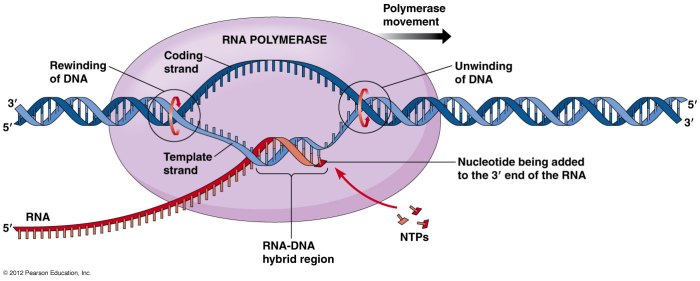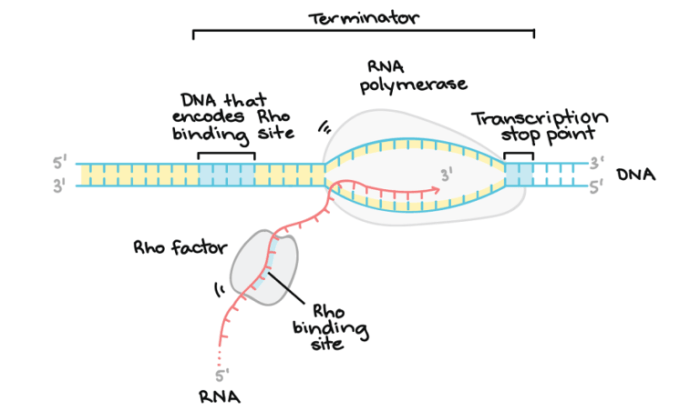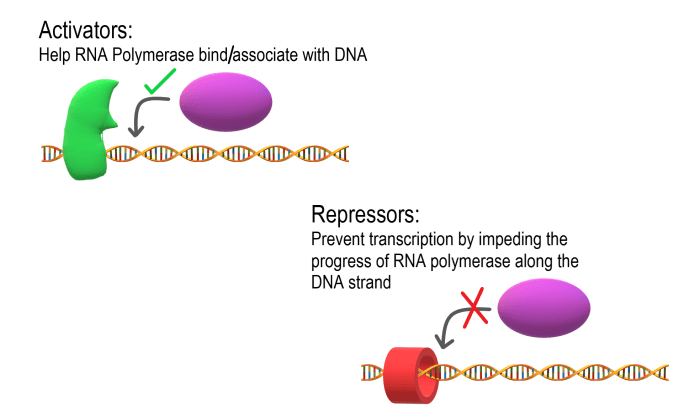Label each element involved in bacterial transcription in the figure – In this comprehensive guide, we embark on a journey to decipher the intricate process of bacterial transcription, exploring the crucial elements involved in this fundamental biological mechanism. Through an in-depth analysis, we will unravel the roles of RNA polymerase, sigma factors, and other essential proteins, as well as the structure and function of DNA as the template for transcription.
Prepare to delve into the fascinating world of bacterial gene expression and gain a profound understanding of the molecular machinery that orchestrates this remarkable process.
Bacterial transcription is a vital step in gene expression, enabling the synthesis of messenger RNA (mRNA) from a DNA template. This intricate process involves a complex interplay of proteins, enzymes, and regulatory elements, working in a highly coordinated manner to ensure the accurate and efficient production of mRNA.
Bacterial Transcription Process: Label Each Element Involved In Bacterial Transcription In The Figure

Bacterial transcription is the process by which DNA is copied into RNA. This process is essential for gene expression, as RNA is used to direct the synthesis of proteins. Transcription is carried out by a large protein complex called RNA polymerase, which binds to the DNA template and synthesizes a complementary RNA molecule.
DNA Template
The DNA template is a double-stranded molecule that contains the genetic information for the cell. The two strands of DNA are complementary, meaning that they have the same sequence of nucleotides but in opposite orientations. The nucleotides in DNA are adenine (A), thymine (T), cytosine (C), and guanine (G).
The sequence of nucleotides in DNA determines the sequence of amino acids in the protein that is produced.
RNA Polymerase
RNA polymerase is a large protein complex that is responsible for synthesizing RNA. RNA polymerase binds to the DNA template at a specific location called the promoter. The promoter is a region of DNA that is rich in A and T nucleotides.
Once RNA polymerase is bound to the promoter, it begins to synthesize RNA by adding nucleotides to the growing RNA chain. The nucleotides in RNA are adenine (A), uracil (U), cytosine (C), and guanine (G). The sequence of nucleotides in RNA is complementary to the sequence of nucleotides in the DNA template.
Transcription Elongation
Transcription elongation is the process by which RNA polymerase elongates the RNA chain. RNA polymerase elongates the RNA chain by adding nucleotides to the 3′ end of the growing RNA chain. The nucleotides in RNA are added in a specific order, which is determined by the sequence of nucleotides in the DNA template.
The RNA chain grows in the 5′ to 3′ direction.
Transcription Termination
Transcription termination is the process by which RNA polymerase terminates transcription. RNA polymerase terminates transcription when it reaches a specific location on the DNA template called the terminator. The terminator is a region of DNA that is rich in C and G nucleotides.
Once RNA polymerase reaches the terminator, it releases the RNA chain and dissociates from the DNA template.
Post-Transcriptional Modifications, Label each element involved in bacterial transcription in the figure
Once the RNA chain has been synthesized, it undergoes a number of post-transcriptional modifications. These modifications include the addition of a 5′ cap, the addition of a 3′ poly(A) tail, and the splicing of introns. These modifications help to protect the RNA chain from degradation and to ensure that it is properly translated into protein.
Questions Often Asked
What is the role of RNA polymerase in bacterial transcription?
RNA polymerase is the central enzyme responsible for catalyzing the synthesis of mRNA from a DNA template. It recognizes and binds to specific promoter sequences on the DNA, unwinds the DNA double helix, and polymerizes nucleotides to elongate the mRNA chain.
What is the function of sigma factors in bacterial transcription?
Sigma factors are proteins that associate with RNA polymerase to direct it to specific promoter sequences on the DNA. Different sigma factors recognize different promoters, allowing bacteria to selectively transcribe genes in response to environmental cues or developmental signals.
How is bacterial transcription terminated?
Bacterial transcription is terminated when RNA polymerase encounters specific termination sequences on the DNA. These sequences signal the release of the mRNA transcript from the RNA polymerase, allowing the newly synthesized mRNA to be processed and translated into protein.


